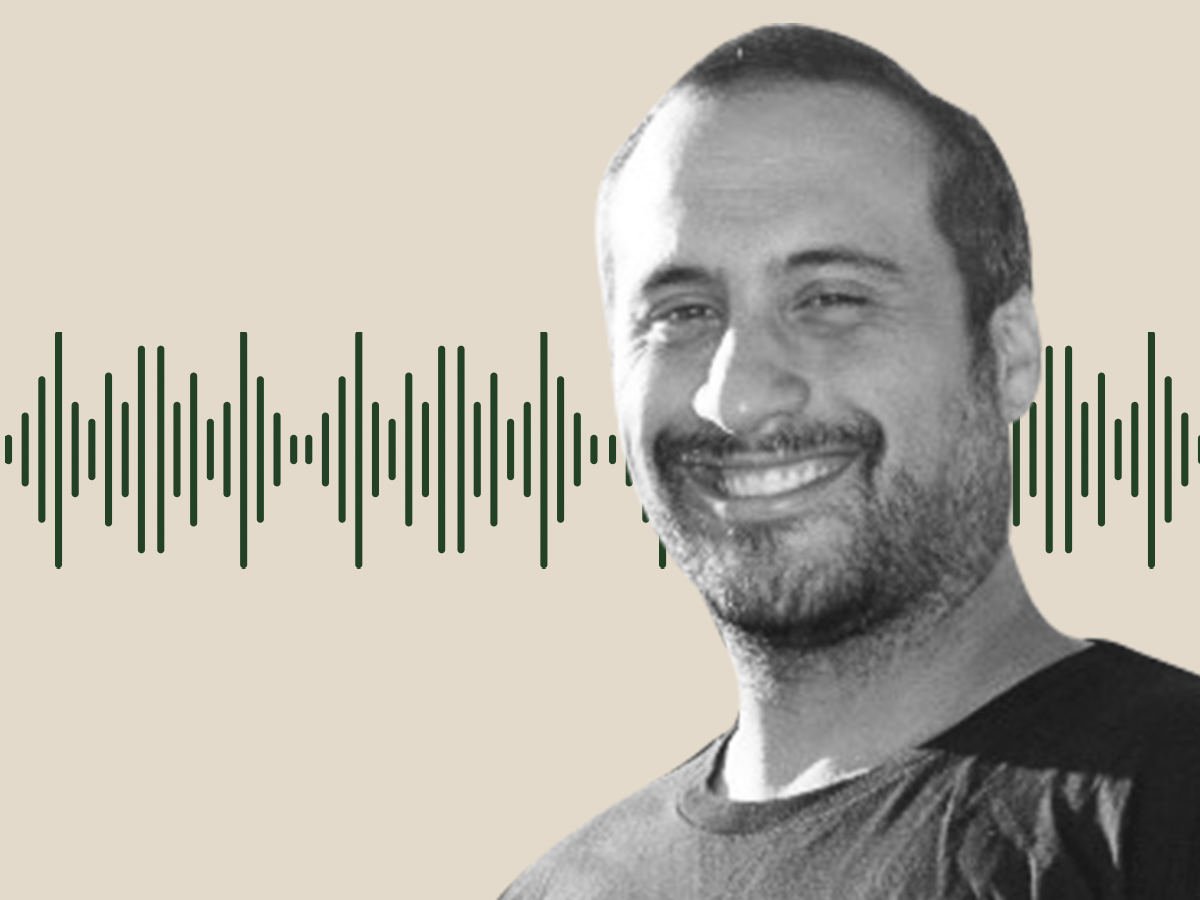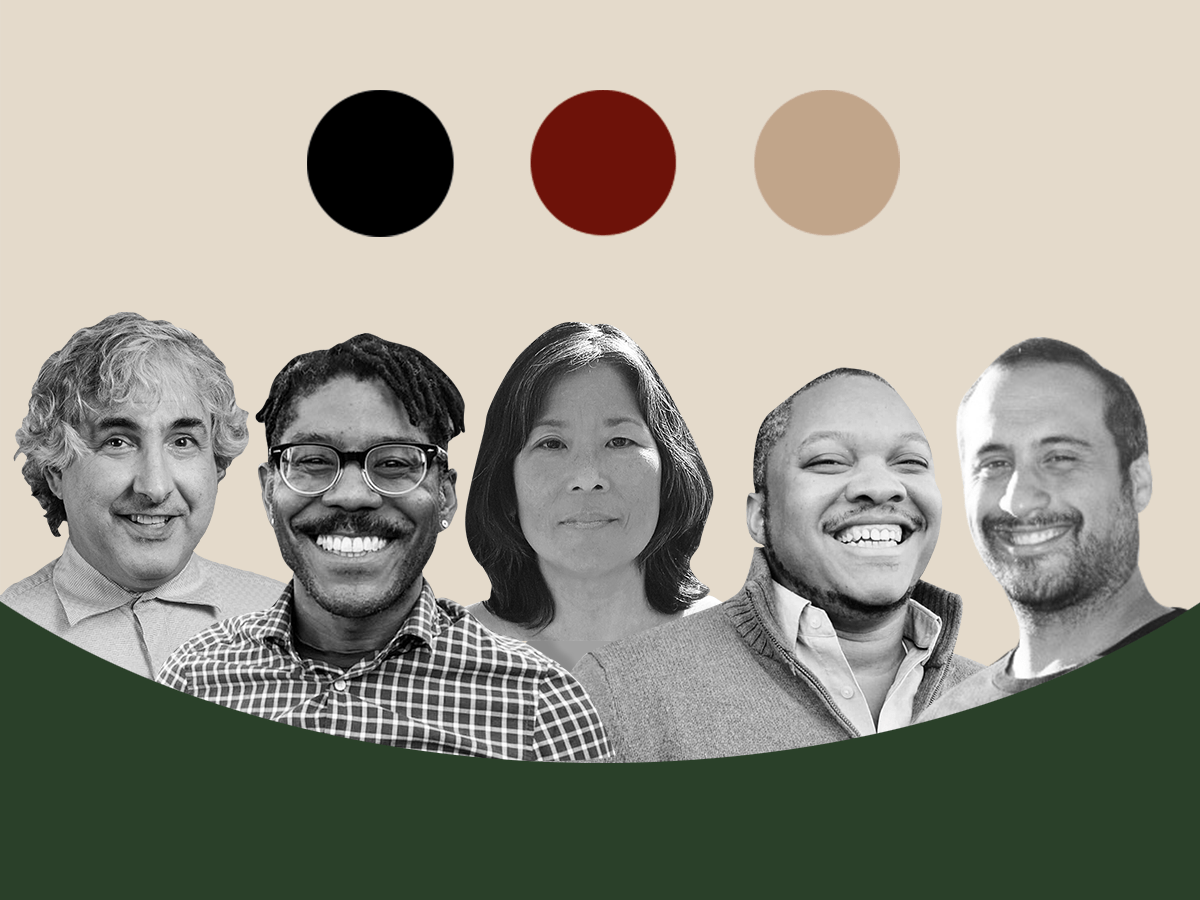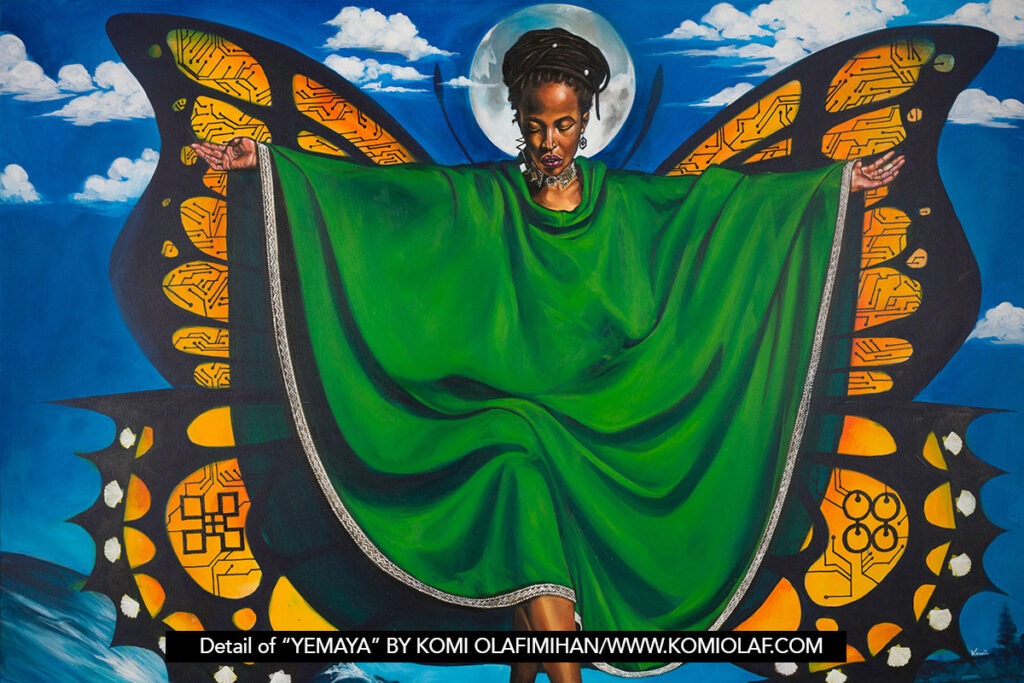
Click here to download this article as it appears in the magazine, with accompanying artwork.
Editors’ note: This article is from the Summer 2022 issue of the Nonprofit Quarterly, “Owning Our Economy, Owning Our Future.”
What follows is primarily the intellectual work of Kamuela Enos, and presents in the first-person voice (his), with assistance from Miwa Tamanaha in producing this work in written form. Kamuela Enos and Miwa Tamanaha are spouses to each other, creative thought partners professionally, and coparents to their children in every space.
This article explores kinship from a Native Hawaiian perspective as a binding construct of “ownership.” Kinship with place—and the integrity of the ecologies, wisdom, and people our places hold—stands as a central tenet of ownership often lost in our contemporary nomenclature born of capitalism.
An important underlying technology Hawai’i has to offer its contemporary self is kinship to land. Kinship is our unbroken connection to our “operating system,” so to speak—the OS of our lands, our complex and interdependent relationship with the ecological systems that allow for life, our ancestral sciences (in service of living in and creating abundance). This connection persists and thrives despite almost two hundred and fifty years of brutal assault, including catastrophic population loss from introduced diseases, racist policies, political overthrow of the Hawaiian monarchy, and deliberate and continuing dispossession of land. It is the foundation for a just, abundant economy in Hawai’i.
Here I share my father’s kinship story, my kinship story, and some of the lessons I have gleaned from living them. This story is a Hawaiian story, but it is repeated across our planet. Vested in kinship to land, the contemporary work of Indigenous communities is iterating prototypes and frameworks for a resilient, just economy.
My Father’s Story, My Story
In the 1970s and 1980s, my father was part of a broad movement of Hawaiians and non-Hawaiian allies who organized in protest of Native Hawaiian land dispossession perpetrated by the U.S. government and U.S. corporations in Hawai’i. In particular, my father sought the return of lands to lo’i kalo.
Lo’i kalo is the ancient Hawaiian practice of cultivating the staple crop of kalo (taro) via wetland terraces. Lo’i kalo was a core engine of precontact Hawai’i’s economy. Lo’i systems are bounded by a waterway that starts at the headwater at the top of a valley, passes through terraced farms, and exits into an estuary. The nutrients that feed these parcels also nourish nearshore and pelagic (open sea) fisheries. From nearshore to mountaintop, this system is contained in the land unit of the ‘ahupua’a (basic self-sustaining unit)—where all of the complex carbs and lean proteins, building material and medicines, and implements for the creation of weapons can be developed in a hyperlocalized, highly skilled economy.1 Absent the forces of industrialization and colonization, Native Hawaiians were self-sufficient, not only on our islands but also in our valleys.
My father’s and his peers’ efforts to reclaim lo’i kalo and bring it back to life was driven by the needs of the Native Hawaiian community of their time. Generations of displacement of Native Hawaiian people and families by colonizing forces had relegated many to conditions of dire poverty. I was raised in the public education system in a community that was predominantly Native Hawaiian, at a time when the dominant narrative told us our ancestors were savages and that our occupation by colonizers could (if we acted correctly) afford us the comforts of modernity for which we should be grateful. The idea of restoring lo’i kalo in this context seemed absurd to many, but my father held to a conviction that reclaiming the brilliant innovations of our ancestors is central to restoring well-being for all people for whom Hawai’i is home.
On the land my father reclaimed and stewards today, Ka’ala Farm, I walked with my ancestors.2 I learned to be attuned to how water flows, how nutrients move along those pathways, and how cleverly the waterways had been designed and constructed.
In the dominant economic model of the time, the role of the people of our community was labor. If you were lucky, skilled labor. Even ownership of businesses by local community members often required their participation in the degradation of the landscape and practices. This was the pathway provided for economic development—we were to understand it was the only way.
We continue to restore the broad systems our ancestors deployed at scale and replicated across the archipelago—systems that allow for the production of goods and services, are greeted by an eager market, and are not extractive/ do not externalize the cost of production onto people and landscape.
My father and his peers came to question why the lo’i kalo—the core engine of an economic system that served the people of Hawai’i for centuries—could not be a viable means of regional economic development that centers people, place, and ecology. They asserted that it could. The lo’i kalo of Ka’ala Farm and like spaces across the Hawaiian archipelago have taught and inspired thousands of young people. Today, more people on more lands are restoring the flow of water and growing food for their communities than has been seen in well over a century. The economic development to which my father and his peers demanded access is an ever-growing reality.
I continue to live this story; it forms the foundation of the ideas I share in the following section. The steps I outline are not a checklist or recipe. These steps articulate practical lessons and a path made by walking, learning from, and living into my father’s story today toward a future we all cocreate.
An Indigenous Vision of Economics
Step One: We Restate Our Value
Where some saw a savage past, my father saw regional economic development. Today, Hawaiian knowledge, practices, and brilliance are still often relegated to the past—albeit, perhaps, romantically—by boxing them up as “Hawaiian culture.” We continue to resist the box. We have been bequeathed ancestral sciences and technologies of integrated systems management that we continue to innovate. We continue to restore the broad systems our ancestors deployed at scale and replicated across the archipelago—systems that allow for the production of goods and services, are greeted by an eager market, and are not extractive/do not externalize the cost of production onto people and landscape.
Step Two: We Uphold Standards—The Triple Piko Analysis
In bringing forward ancestral sciences and integrated systems management to our contemporary context, we must continue to support standards with rigor (recent history is rife with examples of appropriation of Indigenous ideas, innovations, sciences, and technologies). The Triple Piko Analysis is a framework with
built-in principles of practice that protect it from cultural appropriation and subsequent mishandling.
Revered Hawaiian Elder Uncle Kekuni Blaidell taught me the term piko, which means “portal.” He noted that the ancestors of Hawai’i had identified in the physical body three portals connected to the past, the present, and the future: the fontanelle (Piko O), the navel (Piko I), and the genitals (Piko A). They define kinship to past people, present people, and future people, and represent a unified transect in which all decisions are to be vetted: continuity of the work of your ancestors; application/practice and relevance to those alive with you now; and generative abundance provided for future generations.3
Sign up for our free newsletters
Subscribe to NPQ's newsletters to have our top stories delivered directly to your inbox.
By signing up, you agree to our privacy policy and terms of use, and to receive messages from NPQ and our partners.
Piko O: Alignment with ancestral prerogatives. This first layer of analysis asks you to identify the Indigenous practice(s) you intend to bring to a contemporary space. To protect from co-option/appropriation, this layer of analysis requires you to be specific. Piko O requires you to have researched that practice, to have immersed yourself in that practice, and to share the lineage of your teachers. Ownership, responsibility, and genealogy of knowledge/practice must be put front and center. Figure 1 (below) provides in schematic form an analysis of how Native Hawaiian society operated prior to the period of European colonization.
Piko I: Empowering contemporary generations. The second layer of analysis asks you to articulate how your practice will provide agency to Indigenous communities. How does it affirm, restore, and grow that practice toward the creation of meaningful economic development, educational opportunity, and political support that accrue power to Indigenous people and our ownership of and kinship to our resources, ideas, and stories of our homelands? This work also requires mapping the existing challenges as they are outlined in Figure 2 (next page).
There is a continued need to build strong containers for ancestral sciences and integrated systems management in a contemporary context.
Piko A: Providing a foundation for future abundance. The final layer of analysis asks you to demonstrate how your practice will provide for and protect the agency of future generations to live in and create abundance. At this layer the aperture is widened to encompass not just a specific community, but all peoples. How might the global systems of which we are part move toward alignment with our proven ancestral models for social/ ecological/economic resilience? Figure 3 (next page) provides an illustration of our vision.

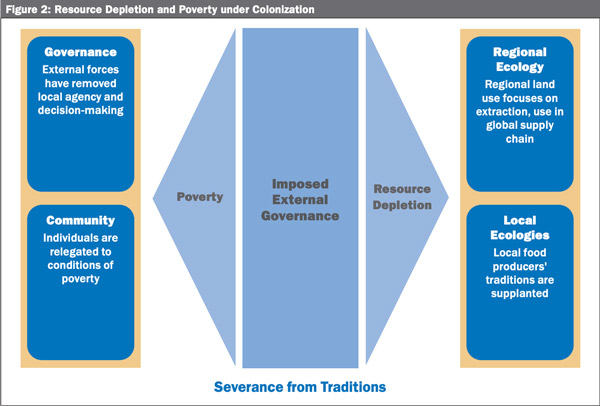
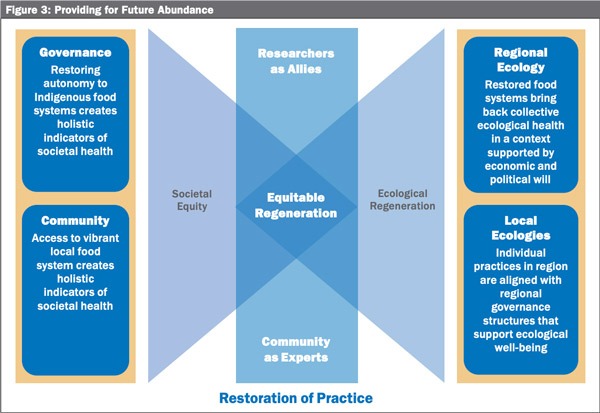
Step Three: The Just Container
There is a continued need to build strong containers for ancestral sciences and integrated systems management in a contemporary context. We must attend to the power structure of the organizations that carry these efforts, and how these efforts receive investment that protects and perpetuates community and practitioner agency, including agency to define our own success.
For over ten years, I worked at a social enterprise in my community, called MA’O Organic Farms.4 Founded by partners Gary and Kukui Maunakea-Forth, MA’O recruits young adults from Wai’anae, a predominantly Native Hawaiian community, to run the daily operations of the farm enterprise in exchange for a full tuition waiver to attend our regional community college. MA’O has grown to become the largest commercial organic farm on the island of O’ahu. At MA’O, our understanding of our success is rooted in the celebration of Makahiki.5 Prior to the U.S. occupation of Hawai’i, chiefs would gather the people in their domain during Makahiki time, and the community would show their bounty—what they had been able to produce—and demonstrate their fitness by performing feats of physical and intellectual strength. MA’O identified and adopted two contemporary Makahiki metrics to help measure the enterprise’s effectiveness: fitness of people as measured by education level, and abundance of land as measured by sales of organic produce. The focus on metrics of meaning has allowed MA’O access to different tables of
decision-making when it comes to the well-being of regional youth and articulating what is the best practice for a rural community.
Step Four: Live Our Agency
I don’t discount the effects of the code-switching that is inherent in walking this path—the complexities and complications and, yes, the compromises. We are called to show up each day whole in our humanity, in a broken world. In all of this, we make the choice to live our agency.
I am convinced now more than ever that our kinship— to land and to each other—shapes our economic futures.
Ka’ala Farm endures, and continues to pave the way for community economic development in Wai’anae and beyond. At MA’O, hundreds of students have received associate’s degrees, affirmed their kinship, and honed their land stewardship practices. In the last few years, MA’O’s farms have secured blended capital to scale from 24 acres of land to 281 acres. In the midst of a global pandemic that has shaken global supply chains, MA’O revenues have soared.
Today, I head the Office of Indigenous Innovation at the University of Hawai’i, where I work to advance and raise resources for our ancestral sciences and integrated systems management—bringing forward the solutions they hold in a contemporary context. I am convinced now more than ever that our kinship—to land and to each other—shapes our economic futures.
Among our learnings to date are the following:
- Native Hawaiian practices are sciences and technologies that sit at the cornerstone of a resilient economy for Hawai’i, and they create the conditions for resilience for Hawai’i (even as defined by other—external— cultures).
- These sciences and technologies thrive today—evidence of their resilience.
- Indigenous communities are now iterating prototypes and frameworks that are attracting the attention of policy-makers, philanthropists, and business leaders globally. Ally support (dollars, political backing, and effective policies and mental models) is needed (and requested) for growth.
- Kinship is a core tenet of an economy that is disruptive, generative, and global.
We see the benefit of this work every day. Ancestral sciences and integrated systems of management are improving soil quality for food production, creating new techniques for native seaweed aquaculture, and innovating climate-adaptation strategies—to name just a few innovations. The outcomes are tangible. The time is now.
***
The practice of ancestral sciences and integrated systems management is not romantic, does not live in the past tense, and is not easy. It is born of commitment and rigor—physical, intellectual, and spiritual. Kinship— like all relationships—requires work: of Indigenous peoples, of immigrants, of settlers, and of the descendants of colonizers. All of us. Zero-sum schemes, scarcity-minded policies, and extractive practices have led us to our current state. Now we have the opportunity to grow a resilient economic future seated in our ancestral sciences and integrated systems management—in the wisdom of our places.
Hawai’i has always been and continues to exist today as a multiethnic polity. In 1883, the sovereign Hawaiian government was overthrown by American plantation owners and business leaders, backed by the U.S. military. In 1993, the United States issued a law, informally known as the Apology Resolution, that acknowledges its role in the illegal overthrow.6 Still, today, Hawaiian lands are occupied by the United States and its military. Land claims remain unsettled. Native Hawaiians and non-Hawaiian citizens of Hawai’i continue to work to shape a just, resilient future for Hawai’i.
The ideas that we share here have been shared with us. First and foremost we must recognize the ancestors of Hawai’i in deified and human form that developed these systems and intentionally designed them to be bequeathable. We also must recognize Kamuela’s father, Eric Enos, and the people he brought to us to be in relationship with, including Puanani Burgess, Uncle Walter Paulo, Uncle Eddie Ka’anana, and Bob Agres. We also recognize Lilikalaˉ Kame’eleihiwa and Jon Osiorio, professors at the Hawai’inuiaˉkea School of Hawaiian Knowledge at the University of Hawai’i, Dolores Foley and Luciano Minerbi, professors in the department of Regional and Urban Planning, University of Hawai’i, and Karen Umemoto, a professor in the department of Urban Planning and Asian American Studies at UCLA. We recognize Kukui and Gary Maunakea-Forth and all the people of MA’O Organic Farms, the many people of, and the lands of, Ka’ala Farm, the Purple Mai’a Foundation, Hawai’i Investment Ready, our ‘ohana KUA, ‘Ewa Limu Project (Uncle Henry Chang-Wo, Wally Ito, and ‘ohana Fuji), Kuˉha’o Zane, Huihui and Luka Mossman-Kanahele, Haˉlau ‘Oˉhi’a and ‘ohana, Aunty Lynette Paglinawan, Dr. Manu Meyer, Kumu Miki’ala Lidstone, and our whole community of peers. Finally, we recognize the Kanaka’ole family—whose matriarch, Edith Kanaka’ole, shared the legacy that she held with all of Hawai’i, and who fundamentally and unabashedly exhibits ancestral practices of sciences and technologies that are rooted in profound spiritual relationship to the living landscape that preceded us, molds us, and continues to guide us in the restoration of abundance.
Notes
- For more on lo’i kalo, see “Ahupua’a: An Introduction: Home,” Library & Learning and Resources, Kapi’olani Community College, accessed May 18, 2022, library.kapiolani.hawaii.edu/ahupuaa; and “Ahupua’a,” Kumukahi, accessed May 18, 2022, www.kumukahi.org/units/ka_honua/onaepuni/ahupuaa.
- “Welina Mai!,” Ka’ala Farm, accessed April 28, 2022, kaalafarm.org/.
- It should be noted that there are many variations on the nomenclature, and the Piko O, Piko I, and Piko A framework was taught to me by my kumu (teachers).
- “Growing Food, Growing Leaders,” MA’O Organic Farms, accessed April 29, 2022, maoorganicfarms.org/.
- “Makahiki,” Ancient Hawai’i, Hawai’i History, accessed April 30, 2022, hawaiihistory.org/index.cfm?fuseaction=ig.page&PageID=534.
- “1993: President Clinton apologizes for 1893 overthrow of Hawaiian monarchy,” Native Voices, accessed April 29, 2022, nih.gov/nativevoices/timeline/578.html.











